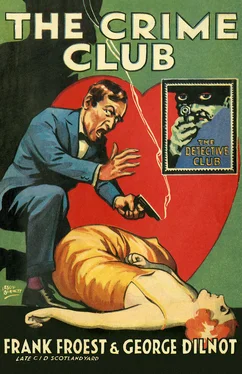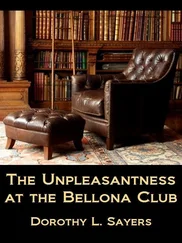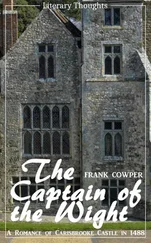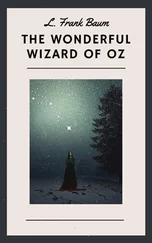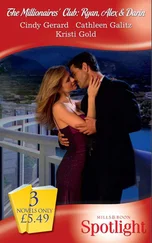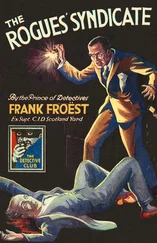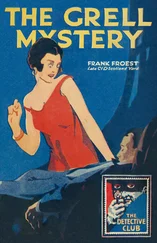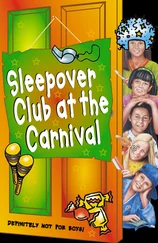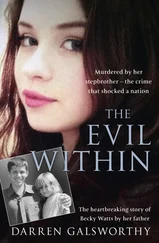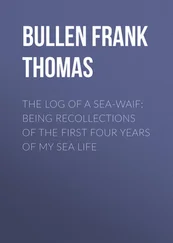When the reissue of The Crime Club came out in 1929, George Dilnot was therefore still very active and by then better known to readers than Frank Froëst. The book enjoyed a new lease of life, and within a year there were 19 titles in the Detective Story Club series. One of the secrets of its success, like so many cheap editions being published at that time, was their availability in newsagents and tobacconists as well as traditional bookshops (many of whom frowned upon the concept of cheap editions and would not stock them). Their success convinced Collins to chase more sales from this market by launching its own monthly magazine, and in June 1930 ‘The Detective Story Club Limited’ published a bold offshoot: Hush Magazine .
Like the book series that inspired it, Hush (the word Magazine being added to its title from issue No. 3) sold for just sixpence and sported brightly coloured covers, usually featuring the clichéd dame in distress, and contained in its 128 pages a mixture of fiction stories and non-fiction articles, some with new line drawings, and a small amount of advertising. The covers proudly proclaimed that the monthly magazine was ‘Edited by Edgar Wallace’, and indeed every issue began with a Wallace story—and usually a page advertising his new Collins book The Terror and/or The Educated Man . But like the more famous and longer-running Edgar Wallace Mystery Magazine that began in 1964, Wallace was not involved; the compilation and editing was by an uncredited George Dilnot. He adapted his own The Story of Scotland Yard , serialised every month from issue No. 3, and recycled some of his stories from The Red Book Magazine , interestingly dropping Frank Froëst’s name from them.
Hush Magazine ceased publication after only a year with No. 13 dated June 1931. There was no indication inside that it would be the last, with two ‘Next Month …’ adverts appearing in its pages. Collins was not a magazine publisher, and either the effort of compiling a varied and illustrated monthly collection of stories had got too much for them, or the circulation figures simply dropped below a sustainable level. Over its run, however, George Dilnot and the team had assembled a respectable if increasingly predictable mix of content, with regular reprints of fiction stories by stalwarts including J. S. Fletcher, Arthur B. Reeve, Sydney Horler, H. de Vere Stacpoole, Maurice Leblanc, G. D. H. & M. Cole, Edgar Allan Poe and even H. G. Wells. The most notable inclusion was a run of five Miss Marple stories by Agatha Christie beginning in November 1930, the month following the character’s very first book appearance in The Murder at the Vicarage , and which would not themselves appear in a book until The Thirteen Problems in June 1932. The publication of one-off detective stories by unknown authors in amongst these popular names provided some interesting reading, but this aspect of the magazine was soon curtailed as it was presumably the well-known names, emblazoned on the covers, who guaranteed sales.
Undaunted after a year on the magazine, George Dilnot returned to writing novels with The Thousandth Case (1932), averaging a book a year throughout the 1930s. His final novel was a Nazi war thriller, Counter-Spy , published by Geoffrey Bles in 1942. At almost 60 years old, Dilnot appears like Frank Froëst to have decided to stop writing ahead of retirement, and died nearly a decade later on 23 February 1951 in East Molesey in Surrey, aged 68.
Of all their books, The Crime Club is probably the least well remembered of any by Froëst or Dilnot, such is the fate of collections of short stories in most writers’ careers. Largely typical of detective stories of their era, the most interesting now is ‘The Red-Haired Pickpocket’ (from The Red Book Magazine , February 1915) as a rare example of a plot being ‘borrowed’ by Sir Arthur Conan Doyle. The solution to ‘The Problem of Thor Bridge’, published in The Strand Magazine in two parts in February and March 1922, and collected in The Case-Book of Sherlock Holmes , is so similar, even down to the small mark on the side of the bridge, that it doesn’t need Sherlock Holmes to deduce that Conan Doyle must have read the Froëst and Dilnot story.
In addition to the dozen stories that comprised The Crime Club , the pair collaborated to write three more in the same vein also for The Red Book Magazine : ‘Crossed Trails’, ‘The Dagger’ and ‘Found—A Pearl’ appeared in the February, August and September issues of 1916. One hundred years later, they are reprinted here for the first time in book form.
If the stories were forgotten, at least their collective title was to live on in another Collins publishing initiative even more ambitious than Hush Magazine —and one with decidedly more success. On 6 May 1930 Philip MacDonald’s detective novel The Noose was the first of the monthly ‘Recommended’ titles to be published by a brand new imprint—the Crime Club. But that is another story.
DAVID BRAWN
March 2016
YOU will seek in vain, in any book of reference, for the name of the Crime Club. Purists may find a reason in the fact that a club without subscriptions, officials, or headed notepaper is no club at all. The real explanation probably is that the club avoids advertisement. It is content to know that even in its obscurity it is the most exclusive club in the world.
No member is ever elected; no member ever resigns. Yet the wrong man is never admitted, the right man rarely excluded. Its members are confined not only to one profession but to the picked men even of that profession. Its headquarters is as unostentatious as its existence—a little hotel handy to the Strand wherein some years ago Forrester and Blake of the Criminal Investigation Department had discovered a discreet manager, a capable chef, and a back dining-room.
The progress of time, and the tact of the manager, had conceded a sitting-room with a dozen or so big and deep arm-chairs. From noon onwards, the two apartments had become sacred to the Crime Club.
Quiet, comfortable-looking men dropped in for luncheon or dinner and a chat that was as likely to cover gardening or politics as murder or burglary. Perhaps the only trait that they showed in common was some indefinable trick of humour that lurked in their faces. An experienced detective has seen too much to take himself too seriously.
The rank and file of the world’s detective services have no entrée to the Crime Club. Only men whose repute is beyond suspicion are among its members. Strictly, it is an international club, for although its most determined frequenters are a dozen Scotland Yard men, there is always a sprinkling of detectives from abroad to be found there. You may see perhaps a thin, hawk-faced Pinkerton man grimly chaffing an excitable, black-bearded little Italian, none other than the redoubtable Cipriano of the Italian Secret Service. In the group about the fire are Kuntze of Berlin—a stolid, bovine-faced man whose looks belie the subtlety of a tempered brain; Heldon Foyle, the tall, urbane superintendent of the Criminal Investigation Department; a jolly-faced, fat officer from the Central Office in New York; the slim-built, grey-moustached commissioner of a great overseas police force—himself an old Scotland Yard hand; a sprucely-dressed Frenchman from the Service de Sûreté; a provincial chief constable; a private inquiry agent so fastidious about the selection of his clients that he is making only a couple of thousand a year instead of the five thousand that could be his if he did not object to dirty hands; and a couple of chief inspectors from the Yard.
Читать дальше
